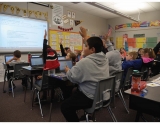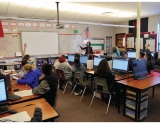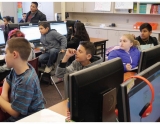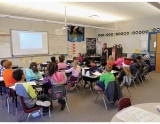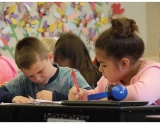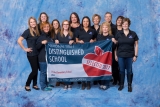-
Category 1
Selected in 2017
-
Grades: pre k - 6
School Setting: urban
Town Population: 86,701
Student Enrollment: 534
Student Demographics:
Black/African American: 1%
Teacher/Student Ratio: 1:23
White/Caucasian: 35%
Hispanic: 62%
Hawaiian/Pacific Islander: 1%
Asian: 0%
Native American: 1%
Other: 0%
% Reduced Lunch: 85%
% ELL Learners: 33%
Founded: 1960 -
PRINCIPAL:
Ross Lunceford -
CONTACT:
550 E. Canfield Dr.
Ogden, UT 84404
801-737-7655
luncefordr@ogdensd.org
Lincoln Elementary School
Ogden, UT
We focus on student needs and always question if our efforts are centered around positive student outcomes.
- Describe specific programs in place to ensure that families are involved in the success of your school and students.
-
Many of our classes have implemented data binders. The data binders go home each week with results from the students weekly assessments. Parents are able to write comments to their students and the teacher. The binder ends up being a nice consistent communication tool between the parent and teacher.
- Describe the most successful activity your school has initiated to strengthen ties to your community.
-
Each school year, Lincoln has invited students and families to attend Literacy and Math nights. Both of these after school events have strengthened the school community by allowing students to learn and work alongside their families.
Lincoln has also had a yearly Dr. Seuss day where local and state leaders such as the Ogden City Mayor come into the building to read to every class and participate in a school wide assembly celebrating not only Dr. Seuss but the literacy goals for our school.
- Describe your philosophy of school change or improvement.
-
School change/improvement is difficult because it entails changing habits, beliefs, traditions, embedded culture. Some of the beliefs, habits, etc are not necessarily bad they just may not be as effective as other items or centered around student achievement. In order to change a school the adults in the building have to experience a change of habits. The first step is to develop habits with the adults that will build a strong community. Setting a vision is of utmost importance. The staff needs to know what they are working towards. The staff needs to experience many wins as they inch closer to helping the school reach the vision. Old habits are difficult to end so there needs to be new habits introduced to take the place of the old habits. Teachers and students working towards goals and recognizing when they reach those goals; helps move the change needle. When goals are not met it needs to be looked at as a learning opportunity to change/adjust the practice to make it more effective. We also believe that improvement involves consistency and regularly checking up on our goals to decide next steps. Complacency is not an option. Working at a Title 1 school with students that are constantly changing and growing we have to be willing to diagnose the ever changing needs of the school. Evaluating those needs allows us to really make changes year after year and constantly strive for improvement.
- What are your school’s top two goals for the next year?
-
Our top goals for next year are to increase our K-3 reading percentage of students at benchmark to 75% and to better our math instruction to have our students reach 65% proficient on the SAGE assessment. In order to work towards our goal of being the best instructors in literacy we have also decided to focus more of our professional development towards phonemic awareness, phonics, and writing instruction.
- What is the single most important factor in the success of your school that others could replicate?
-
Our grade level PLCs are at the foundation of our success. Each week every grade level team has dedicated time to meet and plan ahead using a school wide PLC agenda. This agenda allows every grade and every teacher to work together with coaches, the principal, and any other support staff to plan for upcoming Tier 1 lessons. The PLCs allow for grade level teams to first review assessment data. Next they unpack the standard to help ensure that each teacher is understanding the rigor at what the standard needs to be taught. A common formative assessment is then created with the understanding that teachers have gone through what students should know, understand, and be able to do for each standard being taught. The team chooses one question that best encompasses the whole standard and chooses that question as the exemplar. The teachers then work through the exemplar and agree what needs to be done to be considered a complete answer. The teachers then plan for the week with strategies and activities that will allow their students to show mastery on the assessment. Understanding and honoring the time teachers spend planning for and preparing the best lessons makes the time spent in PLC’s each week that much more important.
- Describe the program or initiative that has had the greatest positive effect on student achievement, including closing achievement or opportunity gaps, if applicable.
-
Our grade level data meetings have had a great effect on our student achievement. We began the data meetings a couple of years ago and have seen growth in our students and our teachers. The core of the data meeting happens before in our PLCs where teachers create a common formative assessment (CFA) based on a state standard. Once the CFA has been created teachers choose one question that they use as their exemplar. All of the teachers in the grade level work through the problem and together as a team they decide what answer they will accept from students. The teachers talk through the components of the exemplar and how they could go about teaching it. Once the CFA is given teachers meet the following week in their data meeting and they analyze student answers in comparison to the exemplar. As the teachers analyze the student work they come up with what errors were made by the students as they solved the problem. Analyzing student work samples across a range of scores from high to low gives teachers the added lense to identify gaps in misunderstanding for their own classes but possibly across the grade. The teachers then plan how they will reteach the standard in order for any student to master the standard. The teachers also create a new assessment to see if the standard has been mastered from the re-teach or not. Asking teachers to dive deeply into weekly data and standard achievement for their class allows them to constantly reflect and have a thorough understanding of exactly where each student stands. We’re not simply analyzing yearly scores to close achievement gaps from year to year; we’re working diligently to close the gaps every day, week, and month so that every student reaches grade level potential.
- Explain how Title I funds are used to support your improvement efforts.
- Title 1 funds are used for additional teachers to help reduce class size. Funds have been used to create a one to one technology ratio with one device/student to allow students to access supplemental curriculum and other resources. Funds are largely used for professional development either to buy PD materials, pay teachers to prepare or attend trainings. Funds have also been used to allow us to partner with the University of Virginia in guiding us through our turnaround.
- Identify the critical professional development activities you use to improve teaching and student learning.
-
In our vision statement we say that in order for Lincoln to be the best we as faculty need to become the best instructors in literacy and math. Our district has a minimal amount of professional development hours scheduled for the school year. As a school we recognized that we needed more time dedicated to professional development. Our faculty meetings are now utilized as 100 percent professional development time. Calendaring and other business items are now taken care of through email. We have worked diligently to ensure that we have a way to measure the effectiveness of our professional development. Determining how we will measure the professional development has proven difficult at times but it has helped guide us in having effective outcome based professional development. Teachers and staff at Lincoln Elementary have been using Professional Development meetings to analyze Guided Reading, Writing, and Science this year. We have used a variety of meeting protocols that allow every teacher to share and participate. These protocols also help facilitate the discussion on what future steps need to be taken next. Two of our favorite protocols are critical friends protocol and the after action review. The critical friends protocol allows teachers to explain a challenge that they have been having in implementing a section of the professional development to their class. Other teachers then are able to share suggestions to help overcome the challenge. The after action protocol is used when we have finished a section of professional development. We answer questions; what was expected to happen?, what actually happened?, What went well and what did not go well? What changes need to be made in order to improve on the training for next time? Professional development is taking place on a monthly basis so that teachers have the opportunity to collaborate, refine their lessons, formulate next steps, and get feedback from their colleagues.
- Describe how data is used to improve student achievement and inform decision making.
-
Data has been a driving force of change for the teachers and students at Lincoln. We start at the macro level with state benchmarks and assessments. We compare grade level performance from year to year. We also look at cohort data and see how the cohort is progressing. The data then gets broken down to the classroom/teacher level. Each teacher knows the benchmark results of all of the classrooms. The teachers take the summative results and make goals with their students for the year. The summative results give us our starting point. Throughout the year we use common interim assessments in ELA, Math and Science. After each interim assessment we hold a deep data dive where teachers analyze their student results and determine which standards need to be retaught at the class level or small group level. Weekly the teachers give common formative assessments in ELA and Math. Teachers work together every week during data meetings to analyze weekly assessments and plan a re-teach to meet the needs of their students. The re-teach data is then addressed at the following PLC for the grade level. School staff also collects attendance and behavior data so that decisions can be made to increase student achievement on a daily, weekly, and monthly basis.
- Describe your school culture and explain changes you’ve taken to improve it.
-
The school culture at Lincoln Elementary begins with the adults. It is one of high expectations centered around achievement. For students we have set the vision of high achievement with academics and behavior. Teachers work diligently with students to ensure that they know the school and classroom procedures. The culture begins with the adults. When Lincoln was not performing up to its potential the adult culture was not as positive and focused that it needed to be for success. For the adults we created a set of 6 culture norms that everyone follows during meetings, time after school, professional development, etc. The norms are as follows; we are fully present and interactive, we value each other’s opinions and efforts, we speak positively about our peers, students and our school, we are all responsible for student learning, we accept failure as a necessary part of the learning process, we rise together;we are all in this together. These norms have become our guiding principles in how we interact with each other and how we can remain positive and optimistic about student success. We have a leadership team comprised of grade level team leaders that works alongside the principal so that we are evaluating and examining the success of our norms and making steps to improve school culture as sometimes it is ever changing. During our current school year our team leaders met with the counselor to discuss the hallway expectations and how the PBIS team or Positive Behavior Intervention Support could help every teacher make our hallways safer. Our school culture has changed a lot over the years and will continue to change or adapt to meet the needs of our staff and students. The most important thing that we are striving for however is to maintain our focus on student needs and always question if our efforts are centered around positive student outcomes.
Stats
-
Category 1
Selected in 2017
-
Grades: pre k - 6
School Setting: urban
Town Population: 86,701
Student Enrollment: 534
Student Demographics:
Black/African American: 1%
Teacher/Student Ratio: 1:23
White/Caucasian: 35%
Hispanic: 62%
Hawaiian/Pacific Islander: 1%
Asian: 0%
Native American: 1%
Other: 0%
% Reduced Lunch: 85%
% ELL Learners: 33%
Founded: 1960 -
PRINCIPAL:
Ross Lunceford -
CONTACT:
550 E. Canfield Dr.
Ogden, UT 84404
801-737-7655
luncefordr@ogdensd.org



